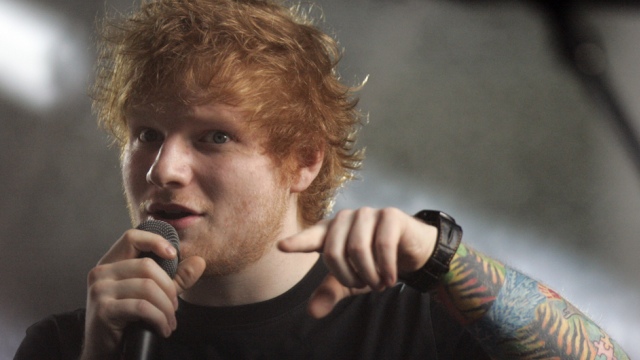There is a significant amount of public recognition in the United Kingdom around having the Christmas number on in the Top 40 singles charts. 2017 saw Ed Sheeran once more sitting like a Christmas-jumper clad angel atop the festive tree with his song ‘Perfect’. But the success of the single shines a light on the challenge facing many Eurovision stars.
What can Ed Sheeran teach the Eurovision Song Contest?
Let’s take a moment to put ‘Perfect’ into context. It debuted on Sheeran’s third studio album, the awkwardly titled ‘÷’ (which from now on is going to be written longhand as ‘Divide’ because Sheeran is not Prince). Released on 3rd March 2017, the modern music landscape meant that every album track was available to stream on the day of release. The album was digested, favourites recognised quickly by his fans, and every (every!) track on the album reached the Top 20 in the singles charts on the week of release.
Streaming has fundamentally altered chart success around the world, especially in the UK, and this is the (ahem) perfect example.
Ahead of the album’s release, both ‘Castle on the Hill’ and ‘Shape of You’ were released in January, giving Sheeran some pre-launch publicity and chart success with some fresh material. The double release after a barren period saw Sheeran easily reach number one (and number two). After the release of ‘Divide’ the next single from the album (‘Galway Girl’) was released two weeks after the album, but familiarity meant that it only reached number two in the UK charts.
The dominance of streaming meant that the peak moment for ‘Galway Girl’ had passed. So how is it that nine months later ‘Perfect’ not only returned to the UK singles charts but grabbed the most coveted number one spot of the year?
In here lies the lesson for delegations at the Eurovision Song Contest. Although some delegations will push back the release of their song as far as possible, they need to be locked in by the Heads of Delegation meeting in mid March, some eight weeks before the votes are cast. The initial peak of the Eurovision 2018 songs will happen long before Lisbon.
For many delegations, there’s the added complication of a National Final. To win the ticket to the Song Contest there needs to be a crescendo for the winning song, and thanks to the connected online world that peak can be heard around the world. After winning selection, a song needs to get ready to create another peak for a fixed time…
…much like ‘Perfect’ had to take the Top 20 appearance in March and nine months of familiarity and put it to good use for the Christmas chart.

I went everywhere for you, I even did my hair for you… (Image: CC Eva Rinaldi)
It’s important to realise that after ‘Ed Sheeran storms the charts’ on ‘Divide’s’ release, ’Perfect’ was pretty much quarantined by Sheeran’s team. His storming set at Glastonbury? No ‘Perfect’. Various live gigs throughout the year? No ‘Perfect’. Media appearances and supermarket openings? No ‘Perfect’.
It was the closest that the creative team could come to making an artistic silence. Yes it was still available to stream as part of the album, but there was no push action to drive Sheeran’s fans back to the likes of Spotify.
You have to wait six months before ‘Perfect’ decides to make an appearance. September 22nd saw a new video released, and it’s a lyric video that accompanied the official single release date of September 26th. The campaign had a focus but there was no significant push action. Only anticipation was being built up.
October was the calm before the storm.
With streaming influencing the charts it’s possible for a longer campaign to be built up around a single release. That was the case with ‘Perfect’ and November was the start of the push. The full music video with Zooey Deutch debuted and that snapped the campaign into focus. Streaming plays started building up and ‘Perfect’ drew more attention, more plays, more fans, and started to climb the charts once more.
November also saw Sheeran release an acoustic version of the song, while remixes by Mike Perry and Robin Schultz also appeared. More attention, more focus, more build.
November 26th saw Sheeran appear on the UK edition of The X-Factor singing the song. While this year’s X-Factor audience was down compared to its heyday, it’s still a great destination for pop music and Sheeran’s appearance drove ‘Perfect’ to Number Three in the charts.
Next up, time to find some new markets with a duet with Beyonce Knowles (December 1st release) and Andrea Bocelli (December 15th).
All of this kept Sheeran in the mainstream media eye, from the entertainment pages of The Sun to more thoughtful columns in The Guardian. The song’s popularity meant it went into heavy rotation on the commercial radio channels, and the ridiculously schmaltzy video was a mainstay of music video channels during December.
From the hardcore fans to the casual followers, from the industry professionals to the general public, the campaign built in frequency and scale as it reached a date with destiny.
By the way, there’s a little known chart rule that counts streams and sales of multiple versions of a single in a single combined ‘sales’ figure. So that’s the September single release (1) , the acoustic version (2), the Mike Perry remix (3), the Robin Schults remix (4), the Beyonce duet (5), and the Andrea Bocelli duet (6). All nicely spaced out over the campaign, all keeping the focus on the song ‘Perfect’ and all combining in the final week of sales and streams to make it to the prestigious top spot.
Sheeran’s ‘Perfect’ campaign was focused on getting as much public support as possible in a fixed timeframe – namely the week of sales and streaming that was measured for the Christmas charts. His team worked with multiple moments on social media (primarily video) to increase momentum as the time approached. The constant new releases over the campaign period not only kept the fan base engaged it but also created moments that mainstream media could easily sell to the general public
From the National Final-esque release of every song on the ‘Divide’ album, through a quiet period, before a focused marketing campaign of personal appearances, social media interaction, and old fashioned ‘dear tabloid newspaper, here’s another story’, Ed Sheeran has provided a modern template to revitalise a winning song for a bigger prize.
Get ready 2018. Every single Eurovision video is going to feature a variation of Ed Sheeran’s kitten pose.

If kittens could kill (Image ‘Perfect’ music video, Warners)










so with that logic why has it not worked for the uk? it has a think the same rhythms of the ed sheeran formula (first the release, music video, eurovision in concert/ uk party, then the graham Norton spot before the ESC week)
i think the fundamentals should not be ignored (song, singer, staging)
i do agree that song need momentum to succeed (Azerbaijan and Armenia this year are great examples of loss momentum) but some song don’t need the pr (portugal)
That Graham Norton spot (and much of the current UK PR) only reaches the UK audience – which is great for UK viewing figures, but they can’t vote for the song!
A lot of Eurovision fans ignore the general world of pop music, but doesn’t happen in a bubble and there’s always something to be learned from mainstream pop. We’re already seeing the influence of the Spotify sound and this Ed-speriment has a lot to offer delegations.
Btw, it makes me think of Lithuania in 2015. “This Time” had won the vote for the Eurovision entry, having been performed in different versions every week for a month. Then suddenly Monika and Vaidas did a Bey & Ed and turned the song into a duet. It revived the song locally and got audiences outside Lithuania interested. The staging in Vienna in turn added another dimension.